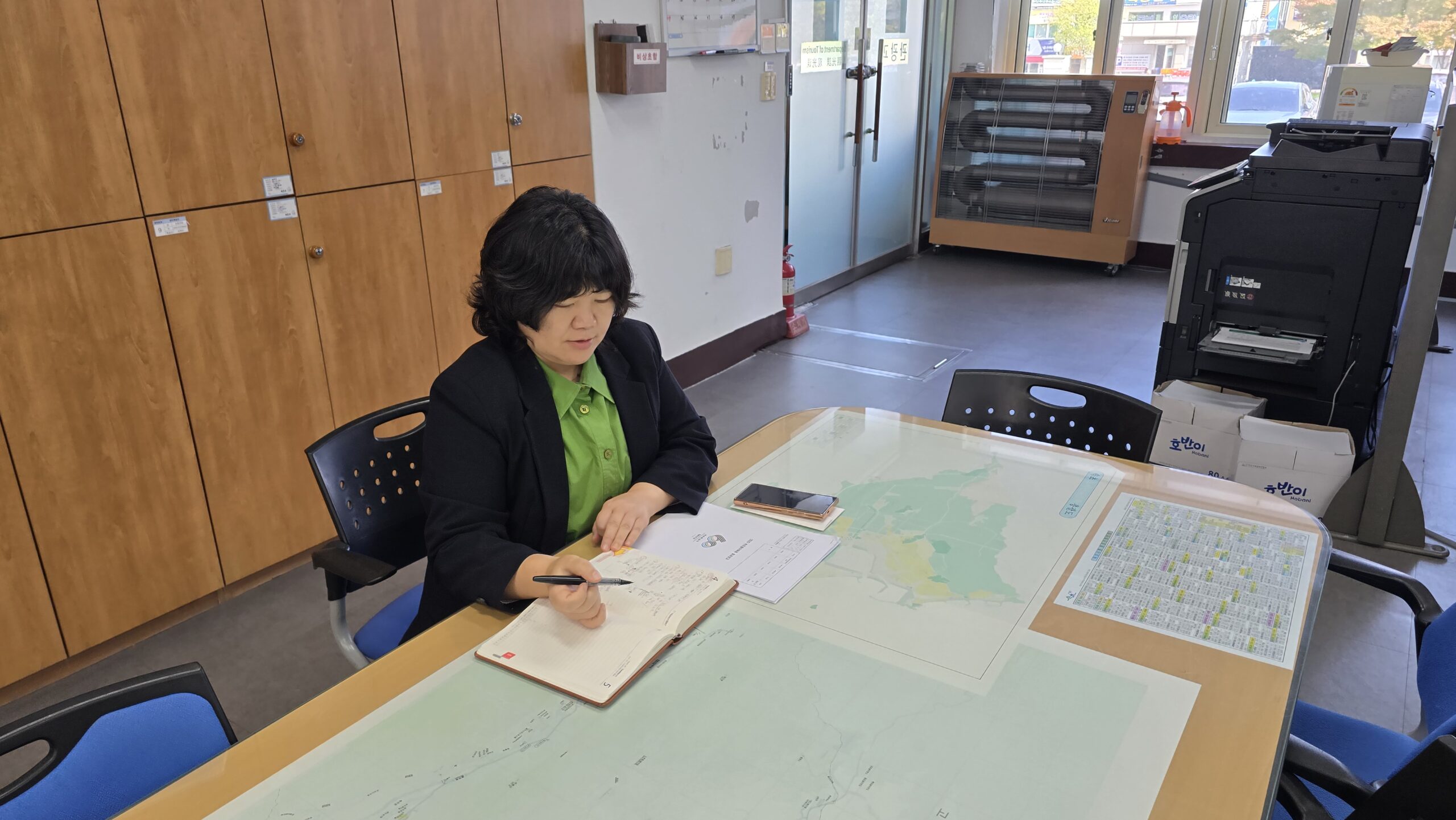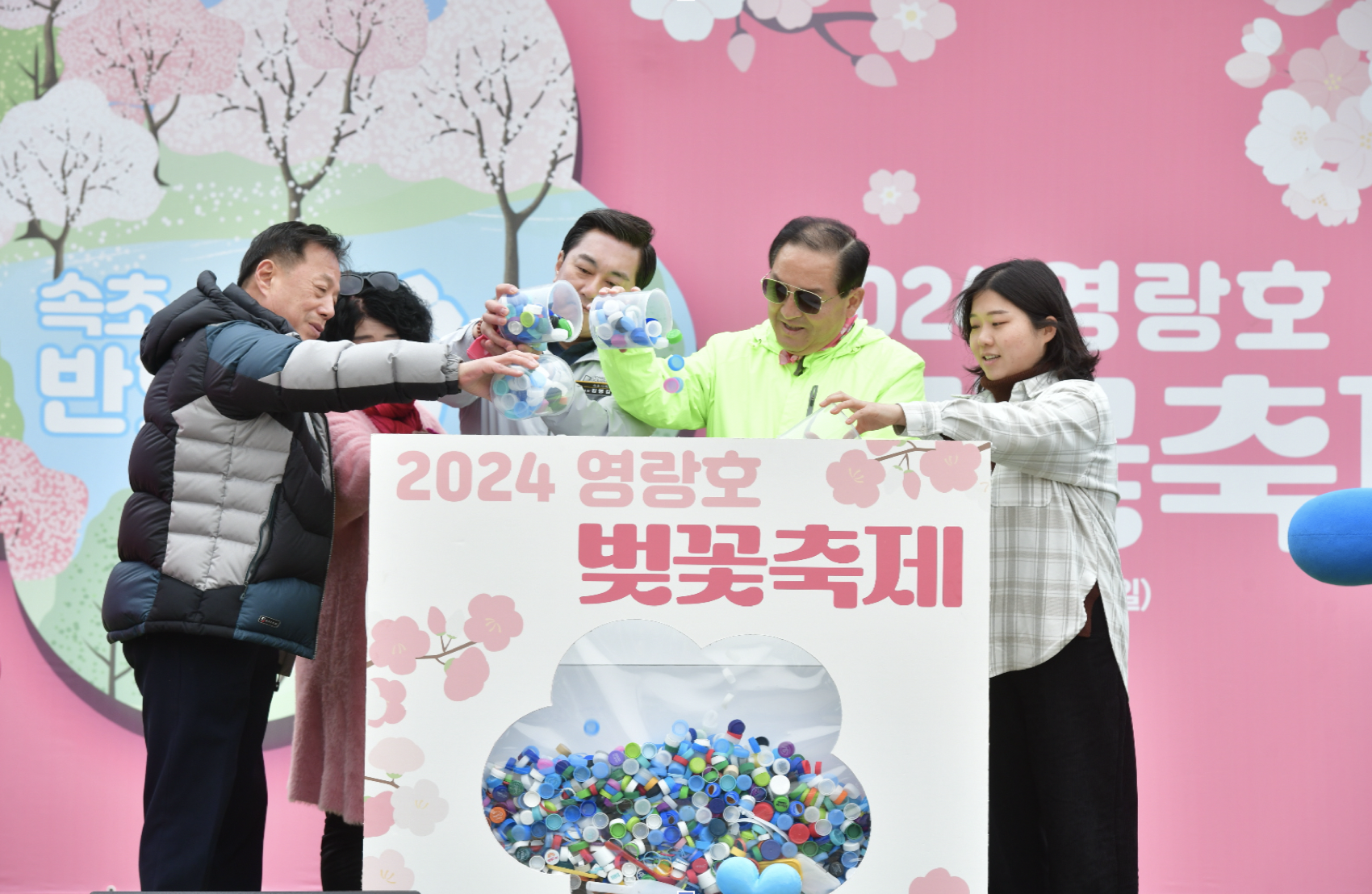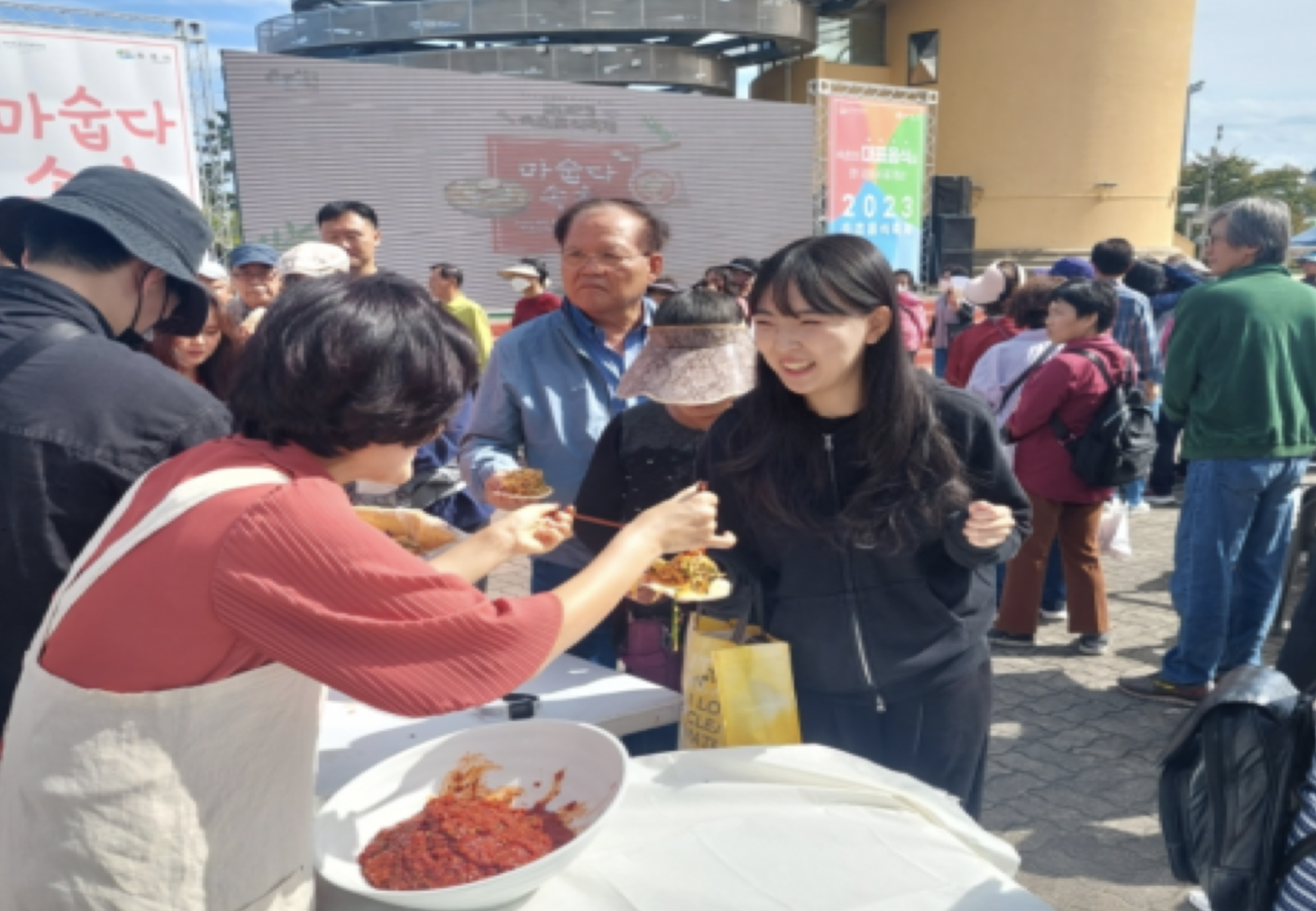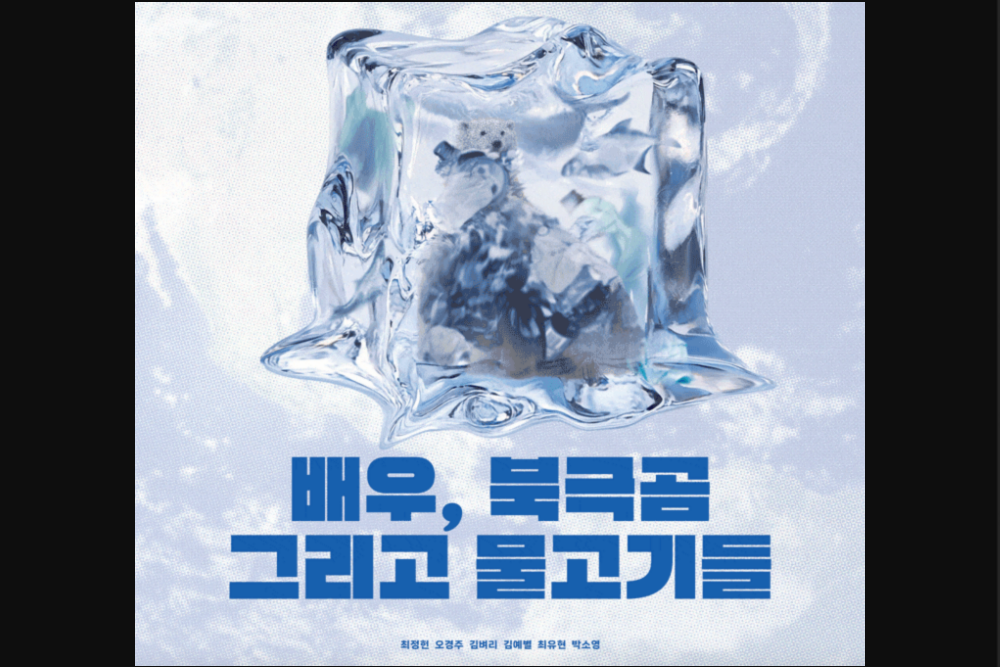This article is based on an interview with Team Leader Kyungsook Kim of the Tourism Marketing and Festival Team, Tourism Department, Economic and Tourism Bureau, Sokcho City Hall.

Please introduce yourself and tell us about the work you are currently responsible for.
We are the Tourism and Tourism Marketing & Festival Team at Sokcho City Hall, and we are responsible for tourism promotion and tourism festival operations. In organizing festivals, our focus is on highlighting Sokcho as a unique tourist destination, emphasizing its distinctive features to differentiate it from other regions.
It’s impressive how the city has integrated eco-friendly elements into its festivals. What led to the inclusion of the ‘Carbon Reduction Campaign’ in most of the festival programs starting from 2023, and what is the background behind planning eco-friendly festivals?
First of all, it’s something that both tourists and citizens have wanted. There has been a strong demand for eco-friendly policies to respond to the climate crisis and reduce carbon emissions. Additionally, the current pledge and goal of Sokcho is to become a ‘Carbon-Neutral Tourism City.’ So, the direction was naturally set in line with this. Sokcho is a city that many people love. In order for them to remember it as a clean and beautiful place and to encourage them to visit again, the aspect of ‘environment’ needed to be highlighted. I believe this alignment of interests made it a natural fit in cultural projects like festivals and tourism promotion. That’s how the planning for eco-friendly festivals began.
There are also many young people in Sokcho. There is a company called ‘Bitnarugo,’ which organizes eco-friendly themed gatherings and environmental education programs. Since eco-friendliness is closely tied to carbon neutrality and wellness, it also connected with fitness crews, leading to projects planned as part of this initiative. The direction of wanting to preserve Sokcho cleanly, combined with the youthful energy of the city, is moving forward harmoniously.
What do you think makes Sokcho special compared to other tourist destinations?
Sokcho is a compact city where nature and urban life harmoniously coexist. Unlike other areas where you need to travel long distances by car to reach major tourist spots, Sokcho offers the advantage of being able to visit most attractions on foot within the city center. For example, there are two lakes in the city, and as soon as you get off at the bus terminal, you can reach Sokcho Beach. Additionally, magnificent mountains like Seoraksan can be accessed by car within 9 to 15 minutes from the city center, making it much more accessible than mountain tourism in other regions. Moreover, you can even enjoy stunning views of Seoraksan’s Ulsan Rock directly from the city, so you can feel the grandeur of nature in your daily life. With its mountains, rivers, and the sea all blending together, I believe Sokcho is the perfect place to experience nature.
Sokcho hosts various festivals: the ‘Yeongrangho Cherry Blossom Festival’ by the lake, the ‘Eco-Vacance’ and ‘Craft Beer Festival’ by the sea, and the ‘Seorak Cultural Festival’ in the mountains. Could you introduce each of these festivals? Also, could you share how Sokcho’s natural environment is reflected in the planning of these festivals?
We’ve been making efforts for a long time to connect the four seasons with the local attractions through festivals. In spring, since Yeongrangho has many cherry blossom clusters, we hold the Yeongrangho Cherry Blossom Festival. In the summer, many regions want to promote the resources they have, so we focus on the sea and hold the Sokcho Sea Festival. In autumn, natural landscapes blend well with festivals, but gastronomy can also be a tourist resource. We’ve tapped into this aspect and created the Sokcho Food Festival. In winter, for those coming to see the first sunrise on January 1st, we organize a New Year’s festival for both citizens and travelers, focusing on local tourism.

(Source: Sokcho City Hall Website > Tourist Attractions > Natural Tourism)
How have you integrated existing eco-friendly campaigns or activities into the festivals?
Actually, these efforts weren’t completely new. There have been ongoing beach clean-up activities through grassroots organizations and club meetings, and local youth have shown a strong interest in environmental issues. So, I thought that by connecting these resources, we could create a bigger synergy. When we held the first Sea Festival in 2023, we collaborated with an organization called ‘Bitnarugo’ to try various eco-friendly initiatives.
For example, we used materials like discarded pallets and old wooden surfboards to create a zero-waste environment. Also, ‘Bitnarugo’ created an eco-friendly toy playground for children, and these installations received a great response from family visitors. It was educational, too. People shared their experiences on social media, which helped spread the word. Since Sokcho is a region centered around tourist attractions, we also planned many activities that could take place on the beach. We organized programs like beach yoga and running, and at the end, we naturally incorporated environmental protection activities, such as a ‘clean-up’ session. In the mornings, we ran these programs, and in the afternoons, we set up festival booths, providing opportunities for various experiences. Regarding the food festival, we actively introduced the use of reusable containers to reduce waste.
At first, it was difficult to hold an eco-friendly festival at a small tourist destination. However, by collaborating with vendors, we replaced disposable items with eco-friendly products and adopted methods to minimize waste. We composted food waste and placed grinders on-site to process it immediately. As a result, there was much less waste, and because the food was delicious, people ate more without leaving leftovers. For photo zones and signboards, we used foam boards made from paper instead of plastic. We also displayed structures shaped like marine animals, and these exhibits were very intuitive, allowing tourists to better experience the eco-friendly atmosphere of the sea.

(from left to right: Yeongrangho Cherry Blossom Festival, Sokcho Sea Festival, Seorak Food Festival)
Most tourists probably visited the festivals thinking of them as just local events, but I’ve heard that they naturally participated in the eco-friendly programs once they encountered them on-site. What do you think led to the positive response from the tourists?
Tourists probably came thinking of the festivals as just local events, but once they arrived and participated, it seems they had more fun and experienced something special beyond their expectations. I think the fact that we prepared a variety of programs that appealed to people of all ages was particularly well-received. For example, there were activities where participants could create something using materials that are usually discarded, like coffee grounds, or make magnets from broken glass pieces, and upcycle bottle caps into keychains. We also had a program where participants could exchange collected shell casings for prizes. These diverse experiences weren’t just fun; they also provided an opportunity to reflect on the environment.
I think participants felt that these activities were not just games, but meaningful experiences, especially as they took home souvenirs or took photos. In fact, the theme of eco-friendliness could have easily felt tiring, but by presenting it through ‘hands-on experience’ and ‘fun,’ we were able to naturally foster empathy and understanding. Ultimately, we were grateful that tourists came to the festival, and through these unique experiences, they had the opportunity to share meaningful moments. I believe that, with gratitude on both sides, everyone could enjoy the festival together.
How was the collaboration with local residents carried out in realizing the eco-friendly festivals?
Collaboration with local residents is fundamental to all of our festivals. So, we worked to connect existing local activities with the festivals to achieve a greater impact. For example, local volunteer organizations actively carried out trash collection and sorting campaigns at the festival site, and we provided guidance and support during the process. Additionally, we worked with not only eco-friendly organizations like ‘Bitnarugo’ but also wellness and fitness groups to run various programs. After these programs, we made sure they continued with environmental clean-up activities. Thanks to the participation of the local community, we were able to naturally incorporate eco-friendly elements throughout the entire festival.
Especially, Sokcho is moving in the direction of becoming a hub for eco-friendly wellness initiatives, and the festival planning team actively incorporated this vision by proposing and collaborating on related ideas. Elements like photo zones and performances were also designed with creative ideas centered around environmental themes. These efforts have received positive feedback not only from internal and external stakeholders but also from the members of our local community. I believe that without this collaboration with the residents, it would have been difficult to achieve the eco-friendly goals of the festival.

Simply planning isn’t enough to align with the name ‘eco-friendly festival.’ It was recognized as a genuine example of practical action and creating meaningful context, rather than just empty words. What do you think made this possible?
First of all, I believe this was possible because there is a clear demand for eco-friendly festivals. The age range of citizens and tourists attending festivals is getting younger, and along with that, their expectations for festivals have changed significantly. Now, many people want experiences where they can contribute to the environment or reflect on its meaning, rather than just attending events focused on eating and drinking. Especially in regions like Sokcho, where the natural environment is beautiful, there is a natural atmosphere of restraint, where people avoid polluting the mountains and the sea because of the festival. Reflecting these changing needs and the local sentiment, we made efforts to incorporate concrete eco-friendly practices into both the planning and operation of the festival.
For example, all materials and activities used in the festival didn’t just end with the word ‘eco-friendly,’ but were actually implemented with practical elements such as recycling, upcycling, and waste reduction. I believe this approach, where people could both enjoy the festival and actively engage in thinking about and contributing to the cause, is why it has been recognized as a good example.
How did you communicate the message of the eco-friendly festival effectively to the visitors?
In order to effectively convey the message of the eco-friendly festival to visitors, we focused on an intuitive approach. Given that it was a Sea Festival, we set up photo zones that naturally evoked images of marine life and environmental conservation, and we made efforts to visually communicate the significance of the event. The focus of the Sokcho Sea Festival was to convey the message that we need to preserve Sokcho’s natural environment. Additionally, in the experiential activities, we included elements that allowed participants to practice eco-friendly values. For example, through a ‘10,000-step walk,’ participants could take part in carbon neutrality, and we ran a program where visitors brought their own containers and tumblers. These small actions played a crucial role in helping visitors experience and embrace eco-friendly values.
Also, the role of the emcees on-site was very important. They didn’t just lead the performances; they actively visited the booths and explained the purpose and meaning of each program to the visitors. They continuously provided guidance on the necessity of using reusable containers and communicated environmental protection messages, taking responsibility for engaging with the festival attendees. As a result, these efforts aligned well with the characteristics of the tourist destination, and many visitors were able to naturally resonate with and participate in the festival and its environmental messages.
What was the response from the visitors who participated in the festival, and were there any specific feedback related to the eco-friendly aspects?
The response from visitors on-site was very positive. Many people took photos and shared them on social media, voluntarily promoting the festival. Thanks to the eco-friendly festival theme, many families participated with their children, and visitors who experienced not only the Sea Festival but also other related events like the Food Festival and Yeongrangho Cherry Blossom Festival provided diverse feedback. During the day, we showcased eco-friendly elements aesthetically through programs like junk art, and at night, we collaborated with ‘Bitnarugo’ to plan lighting and performances using eco-friendly energy. It wasn’t just about delivering a message; we were able to express both beauty and environmental values simultaneously, which received great feedback. With new ideas and professional eco-friendly elements harmonizing together, the festival seemed to offer visitors a fresh and meaningful experience.
What are the main challenges you face when planning or organizing an eco-friendly festival?
“The biggest challenge of organizing an eco-friendly festival is the high cost. People often think that eco-friendly festivals can be done with low costs because they focus on waste recycling, but in reality, a lot of effort is required to balance aesthetics and functionality. First and foremost, festivals must provide beautiful and memorable experiences. To achieve this, additional costs are incurred when using eco-friendly materials and designs while preserving aesthetic elements. For example, using eco-friendly materials like PLA (corn starch-based) or bamboo instead of disposable plastics costs significantly more than regular plastic. When even basic items like chopsticks, spoons, and table covers are made from eco-friendly materials, the cost burden increases substantially.
Additionally, the festival venue must be safe, so there are separate costs for safety management. Especially, eco-friendly products need to be made from materials that are not only environmentally beneficial but also safe, so quality control and inspections are required. Ultimately, an eco-friendly festival cannot be achieved with just a ‘mindset of caring for the environment.’ To make this a reality, more effort, dedication, and financial investment are needed, and I believe that is the biggest challenge.

What efforts did you make to minimize the inconvenience caused by the transition to eco-friendly practices and to maintain visitors’ satisfaction with the existing festival experience?
While transitioning to eco-friendly practices, we had to accept some inconvenience. For example, eco-friendly paper structures are more affected by weather conditions compared to plastic, so there were difficulties in installation and maintenance. We had to repeatedly fix and reinforce collapsed photo zones on-site. Nevertheless, we paid attention to the smallest details to ensure visitor satisfaction. It wasn’t just about using eco-friendly materials; we also focused on design and quality to preserve the aesthetic appeal of the festival and provide a memorable experience.
Additionally, we tried to connect eco-friendly practices with the interactive booths and programs, allowing visitors to experience both fun and meaning. By doing so, instead of feeling inconvenience, we aimed to make the festival feel more special through ‘participation’ and ‘meaning.’ This effort played a significant role in maintaining visitor satisfaction.
Are there any new festivals you are planning?
The years 2023 to 2024 served as a transitional period in planning an eco-friendly wellness festival. Rather than creating a new festival, we planned to enhance the existing ones by incorporating more eco-friendly and wellness elements. If the previous attempts were well received, we now aim to highlight these aspects further while ensuring the festival runs safely. We are committed to making continuous efforts to improve every aspect of the festival.
I’m curious if there were any insights gained from domestic and international cases, and how the examples you researched compare to the case of Sokcho in terms of similarities and differences.
First of all, I tend to get a lot of ideas from experts. I often consult with the representatives I’ve previously worked with to understand the direction and management strategies they’re using nowadays. Apart from that, I do a lot of research on portals and also refer to examples from other cities and even international cases. Materials from organizations focused on climate change response have also been very helpful.
If other regions are looking to model Sokcho’s festivals, what advice would you give on how they can implement carbon neutrality in their own festivals?
Other regions’ festivals are already making great efforts, but to truly practice carbon neutrality, I believe it’s important to deliver practical experiences and messages to visitors through the festival atmosphere and content. For example, it’s essential to have a well-organized program that focuses on waste reduction and thorough separation of recyclables. Additionally, encouraging visitors to directly participate in eco-friendly practices through green events or products is also effective. While we haven’t fully reduced carbon emissions across all aspects of our festivals yet, we are showing the direction through small actions. If festivals in other regions have the courage to expand such events and activities, they can create more meaningful events while naturally engaging with tourists and nature.
What has been the most memorable moment or challenge in planning the festival?
The most memorable moment while planning the Sokcho Food Festival was the Bibimbap performance. We wanted to showcase local specialties, but at the same time, we were thinking about how to do so creatively while minimizing waste. In the end, we used puffed rice as a plate and served a bibimbap in the form of a rice ball, topped with a low-salt fermented fish, a symbolic ingredient of Sokcho. Visitors found it fun, and some even took an extra puffed rice piece and enjoyed it like a ‘rice burger.’ Additionally, performances like handing out rice cakes, where we used environmentally friendly yet creative methods to engage with visitors and share joy, remain very rewarding.














